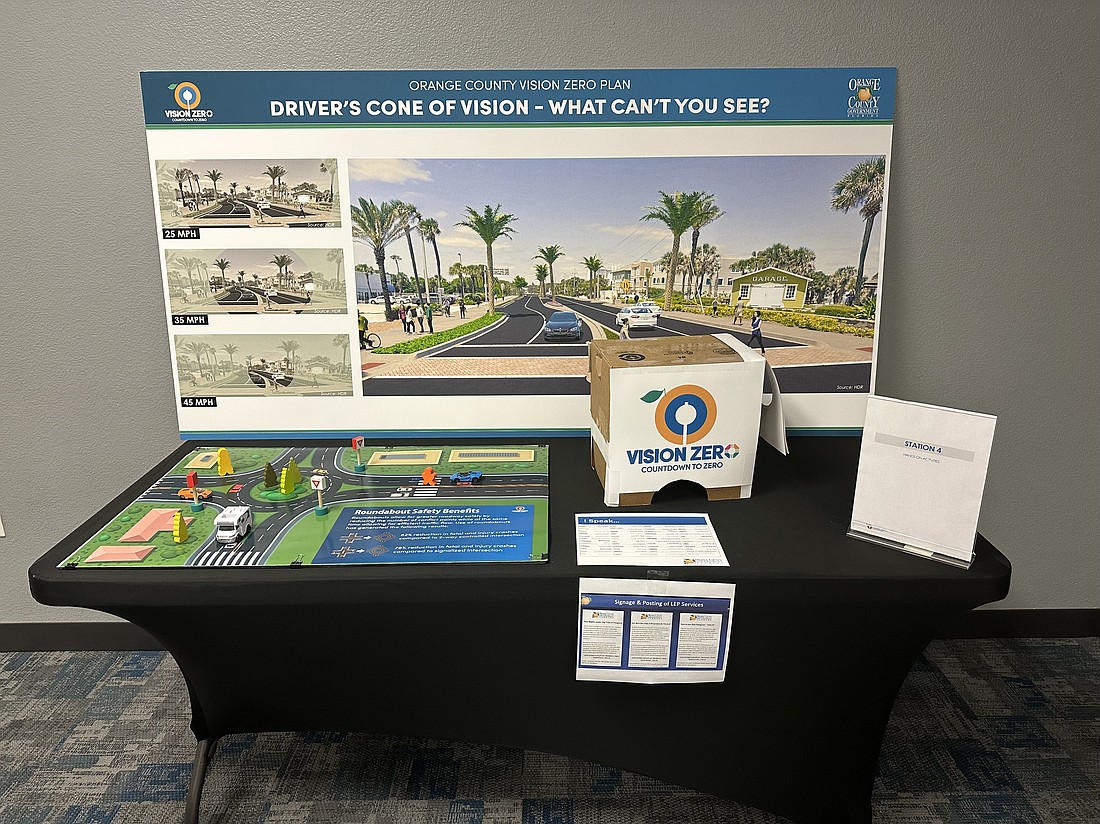- December 22, 2024
-
-
Loading

Loading

After years of planning, Orange County hosted its first Vision Zero Action Plan community meeting Thursday, Jan. 18, at the Rosen Jewish Community Center in Dr. Phillips.
The Orange County Board of County Commissioners in August 2022 voted to adopt the plan.
Vision Zero seeks to eliminate traffic fatalities and severe injuries in the transportation system by providing a proactive and preventive approach. The plan emphasizes loss of life is not an acceptable price to pay for mobility, and the goal is to integrate safety principles during the planning and implementation of transportation programs countywide.
Orange County District 1 Commissioner Nicole Wilson said Vision Zero is a long time coming.
“I look at the champions for Vision Zero in the room, and I think about my residents who feel passionately about this, I think about the people I’ve met in my tenure that have lost people due to traffic accidents,” she said. “Vision Zero is really an opportunity for us to acknowledge that some of those accidents, most of those accidents, could have been avoided. … We see racing and there’s generally bad behavior, but we then blame it on the behavior. … But the reality of it is we have to actually change our mindset and the way that we’re thinking about this. The way that we’re thinking about growing, the way we think about developing and the way we think about the way we want our community to feel should be human-centric, not car-centric.”
WHAT IS VISION ZERO?
The Orange-Kissimmee-Sanford metro area continues to rank as one of the deadliest areas, and the average annual deaths continue to rise.
In 2022, there were 209 fatalities and 1,208 severe injuries on Orange County’s roadways.
Coordinated action plans will be created for cities and counties throughout the region made possible by a $3.8 million federal Safe Streets for All grant.
Vision Zero acknowledges many factors contribute to safe mobility, including roadway design, speed, behaviors, technologies and policies. Strategies include using rectangular rapid-flashing beacons, raised crosswalks, leading pedestrian intervals, pedestrian crossing islands, pedestrian hybrid beacons, road diets, and crosswalk visibility enhancements to protect pedestrians and bicyclists from vehicles.
The Vision Zero brand helps to generate visibility and familiarity to achieve campaign participation community wide. The brand showcases the image of the roadside memorial, an all-too-familiar reminder of the personal impact roadway crashes can have on individuals and communities.
The completed plan will include a high injury network; equity component; list of priority streets and intersections; educational and enforcement programs; and a sustained effort.
Through MetroPlan’s regional dashboard, which relies on the Signal Four Analytics database maintained by the University of Florida’s GeoPlan Center, residents can view data that provides a comprehensive view of crash statistics, including type, severity, manner of collision, and overall injury and fatality trends for the given period.
“Our mindset has always been to blame the pedestrian, to blame the bicyclist, and the car got priority,” Wilson said. “We built our communities with cars as the priority, and, really, it’s not sustainable, it’s not healthy, and it’s not safe. … We’re not talking about a humongous upturn of our existing structure. It’s about going back and making it human-centric everywhere we can, so that we can walk and bike and use our transportation system in any way possible to continue to allow us to be participants in our community.”
HUMAN-CENTRIC
Roberta Fennessy, who leads the consultant team, said Vision Zero needs community input.
“You all are our boots on the ground,” she said. “These are your roadways that you live and drive on a daily basis. We need that finer grain of knowledge base from you all.”
The District 1 meeting was one of six public workshops, one per district, that will be taking place as part of the public engagement process. There also will be two pop-up events.
Orange County staff member Roberto Ng gave a short presentation at the meeting.
“There is an epidemic that is happening in our communities,” Ng said. “We must tackle it head-on because there is a severe and astounding number of fatalities for pedestrians and bicyclists. … We’re not here about traffic, we’re here about quality of life and safety.”
From 2018 to 2022, Ng said there were more than 327,000 crashes, which equates to one crash every 8.5 minutes. Of those, there were about 1,475 fatalities and 9,500 severe injuries.
“Is that acceptable?” Ng asked. “By no means. We must do something, and we must do it now.”
Residents who attended the meeting were able to participate in interactive stations throughout the room that focused on identification of safety concerns, countermeasures and hands-on activities.
The Orange County Vision Zero Steering Committee has been meeting since October and will continue to meet through March to assist with strategy development for the remaining phases of the plan, as well as provide key input and advice for the plan.
The next Vision Zero meeting will take place at 6:30 p.m. Thursday, Jan. 25, at the John Bridges Community Center.